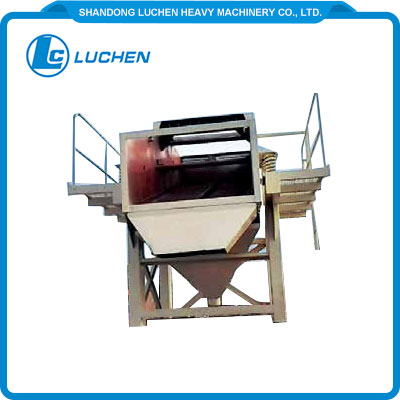Information about Vibrating Sieve Stone Washers
2024-07-28
A vibrating sieve stone washer is a specialized equipment used in the mining, construction, and aggregate industries to clean and sort stones and other materials. It combines the functions of a vibrating sieve (or screen) and a stone washer to achieve efficient separation and cleaning of materials. Here’s a detailed overview:
Key Features:
1. Vibrating Sieve:
- Screening: The vibrating sieve component uses vibrating screens to separate materials based on size. It effectively sorts stones, gravel, and other aggregates into different size fractions.
- Vibration Mechanism: The sieve vibrates to facilitate the movement of materials across the screen surface, ensuring that particles are sorted effectively.
2. Stone Washer:
- Cleaning: The stone washer component is designed to wash and remove impurities, such as mud, clay, and dust, from the stones and aggregates. It typically includes a washing drum or tank where the materials are subjected to water and agitation.
- Washing Mechanism: The washing mechanism can vary, including rotating drums, spiral washers, or other methods to ensure thorough cleaning.
3. Construction:
- Materials: The equipment is generally constructed from durable materials such as steel or high-strength alloys to withstand the rigors of heavy-duty operations.
- Design: Often features a robust and modular design to allow for easy maintenance and operation.
Applications:
1. Mining and Quarrying:
- Ore Processing: Used to clean and sort mined ore or aggregate materials, removing impurities and ensuring that only usable material is processed further.
- Aggregate Production: Employed in aggregate production facilities to prepare and classify aggregate materials for construction purposes.
2. Construction:
- Material Preparation: Used in construction sites to clean and sort stones and gravel before they are used in concrete mixes, road construction, and other applications.
3. Recycling:
- Construction Waste: Helps in cleaning and sorting recycled construction materials, ensuring that they are free of contaminants and suitable for reuse.
Benefits:
1. Efficiency: Combines screening and washing functions into one machine, reducing the need for separate equipment and improving overall efficiency.
2. Clean Materials: Ensures that the materials are thoroughly cleaned of impurities, improving the quality of the final product.
3. Versatility: Can handle a variety of materials and sizes, making it suitable for different types of aggregate and mining operations.
Components:
1. Vibrating Screen:
- Screens: Typically includes multiple layers of screens with different mesh sizes to sort materials into various size fractions.
- Vibration Motors: Powered by electric motors that create vibrations to move materials across the screens.
2. Washing Drum/Tank:
- Agitation: Includes mechanisms such as paddles or spirals to agitate the material and ensure thorough cleaning.
- Water Supply: Connects to a water supply system for washing the materials.
3. Discharge Systems:
- Conveyors: Includes conveyor belts or other systems to transport sorted and cleaned materials to storage or further processing.
Maintenance:
1. Regular Inspection:
- Screen Condition: Regularly inspect the screens for wear and tear, and replace them as needed.
- Washing Mechanism: Check the washing mechanism for proper operation and any signs of wear.
2. Cleaning:
- Debris Removal: Keep the equipment clean and free of debris to maintain efficiency and prevent clogging.
- Water System: Ensure that the water supply and drainage systems are functioning correctly.
3. Lubrication:
- Moving Parts: Lubricate moving parts such as bearings and motors to ensure smooth operation and prevent mechanical failure.
Selection Considerations:
1. Material Type and Size:
- Capacity: Choose a machine with a capacity and screen size that match the types and quantities of materials you need to process.
- Washing Needs: Ensure that the washing mechanism is suitable for the level of contamination and type of material being cleaned.
2. Durability and Construction:
- Build Quality: Opt for equipment with high-quality construction to withstand harsh operating conditions and ensure long-term reliability.
3. Maintenance Requirements:
- Ease of Maintenance: Consider the ease of accessing and maintaining various components, including screens, washing mechanisms, and motors.
4. Cost and Budget:
- Budget Constraints: Balance the features and performance of the equipment with your budget to ensure you get a good value for your investment.
A vibrating sieve stone washer is a versatile and efficient piece of equipment for cleaning and sorting materials in various industries. By carefully considering the features and requirements of your application, you can select the right equipment to meet your needs effectively.



